Table of Contents
Are you planning a trip to the Iberian Peninsula and can’t decide between Portugal and Spain? Both countries have a lot to offer, from beautiful beaches to vibrant cities, from rich cultural heritage to delicious cuisine. In this article, we’ll compare Portugal and Spain in several categories to help you make an informed decision and plan your perfect vacation.
Location and geography are the first things to consider when comparing Portugal and Spain. While both countries are located on the Iberian Peninsula in southwestern Europe, they have different landscapes and climates. Portugal is known for its rugged coastline, rolling hills, and sunny weather, while Spain boasts diverse regions, from the snowy peaks of the Pyrenees to the sandy beaches of the Mediterranean. Historical and cultural differences are also apparent, with Portugal having a more laid-back vibe and Spain being more lively and flamboyant. So, whether you’re looking for a relaxing beach holiday or an adventurous city break, Portugal and Spain have something for everyone.
Key Takeaways
- Portugal and Spain are both located on the Iberian Peninsula but have different landscapes and climates.
- Portugal is known for its laid-back vibe, while Spain is more lively and flamboyant.
- Both countries offer a mix of historical and cultural attractions, delicious cuisine, and beautiful scenery.
Portugal vs Spain: A Tale of Two Countries
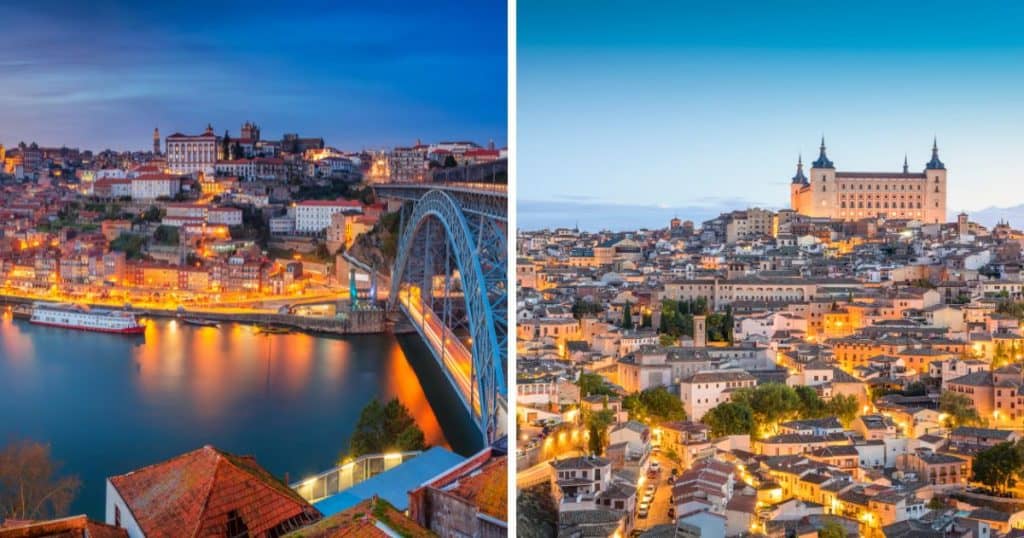
Are you planning a trip to the Iberian Peninsula and wondering which country to visit? Portugal and Spain are two neighboring countries that share a rich history, culture, and language. However, they have distinct differences in terms of location and geography that make them unique and worth exploring. In this article, we will compare and contrast Portugal and Spain, so you can decide which one to visit.
Location and Geography
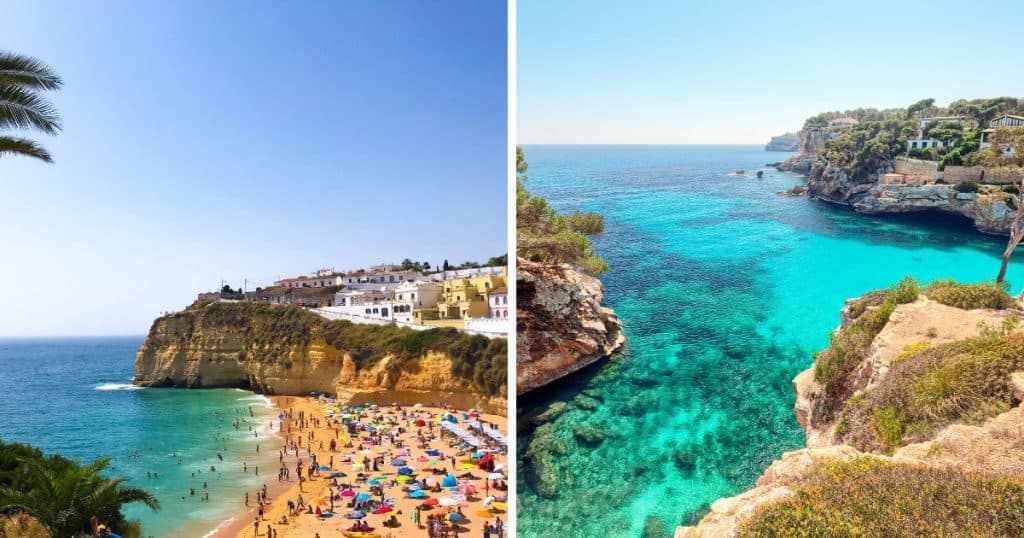
Portugal and Spain are located in southwestern Europe, on the Atlantic coast of the Iberian Peninsula. Portugal is the westernmost country in Europe, and Spain is the second largest country in Europe after France. They share a border that stretches for 1,214 km, and they are both members of the European Union.
Portugal’s Geography
Portugal has a diverse landscape that includes mountains, forests, beaches, and islands. The country is divided into two main regions: the mainland and the Azores and Madeira islands. The mainland is mostly flat in the north and hilly in the center and south, with the highest peak being Serra da Estrela at 1,993 meters. The coastline is rugged and indented, with sandy beaches and rocky cliffs. The Azores and Madeira islands are volcanic in origin and offer a subtropical climate, lush vegetation, and breathtaking scenery.
Spain’s Geography
Spain has a varied landscape that includes mountains, plains, plateaus, and coasts. The country is divided into 17 autonomous regions, each with its own geography, culture, and language. The Pyrenees mountain range forms a natural border with France and separates the country into two distinct regions: the north and the south. The north is green and mountainous, with the Picos de Europa and the Sierra Nevada mountain ranges. The south is dry and arid, with the Andalusian desert and the Sierra Nevada mountain range. The coastline is long and varied, with sandy beaches, rocky cliffs, and coves.
In conclusion, Portugal and Spain are two countries that offer a unique blend of history, culture, and nature. Portugal has a diverse landscape that includes mountains, forests, beaches, and islands, while Spain has a varied landscape that includes mountains, plains, plateaus, and coasts. Whether you prefer the rugged coastline of Portugal or the sunny beaches of Spain, both countries have something to offer for everyone.
Portugal vs Spain: A Historical Overview
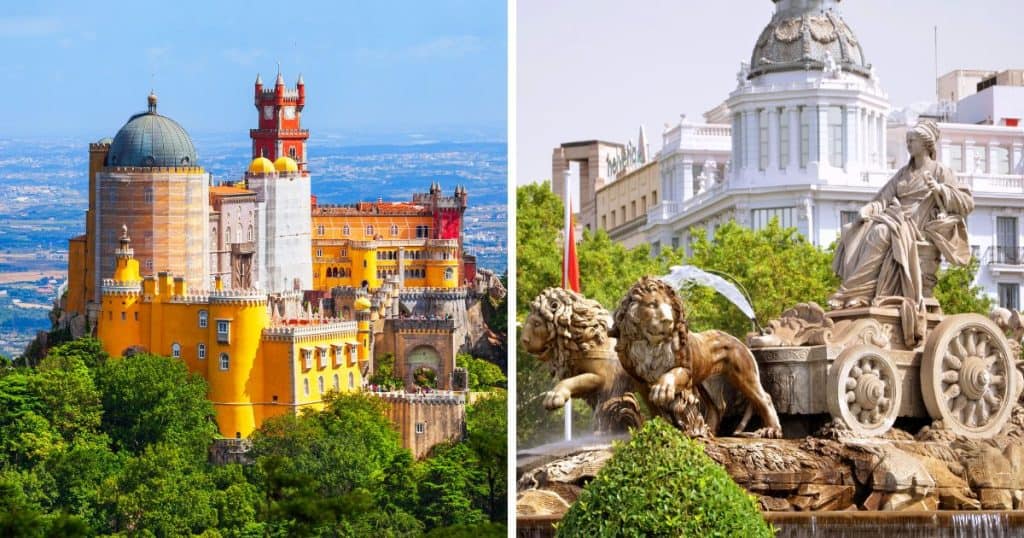
Are you planning a trip to the Iberian Peninsula and wondering which country to visit? Portugal and Spain are two beautiful countries with a rich history and culture. In this article, we will take a closer look at the historical background of these two nations and highlight some of the key differences that make them unique.
Portugal’s History
Portugal is a small country located on the western coast of the Iberian Peninsula. It has a long and storied history that dates back to the Roman Empire. In the 15th and 16th centuries, Portugal was a major global power, with a vast empire that spanned across Africa, Asia, and the Americas. During this time, Portuguese explorers like Vasco da Gama and Ferdinand Magellan discovered new trade routes and established colonies in Brazil, India, and Angola.
In the 20th century, Portugal underwent a series of political upheavals, including a dictatorship that lasted from 1926 to 1974. However, since the establishment of a democratic government in the mid-1970s, Portugal has become a stable and prosperous country with a thriving tourism industry.
Spain’s History
Spain is a larger country located on the eastern side of the Iberian Peninsula. It has a rich and complex history that spans thousands of years, from the ancient civilizations of the Iberians and Celts to the Muslim conquest in the 8th century and the subsequent Reconquista by Christian forces.
In the 16th century, Spain became a dominant global power, with a vast empire that included territories in the Americas, Asia, and Africa. This period of Spanish history is known as the Golden Age, and it produced some of the world’s greatest artists and writers, including Miguel de Cervantes, Diego Velázquez, and Francisco de Goya.
In the 20th century, Spain went through a period of political instability, including a civil war that lasted from 1936 to 1939 and a dictatorship that lasted from 1939 to 1975. However, since the establishment of a democratic government in the mid-1970s, Spain has become a modern and prosperous country with a rich cultural heritage.
That’s a brief overview of the historical background of Portugal and Spain. In the next section, we will take a closer look at some of the key differences between these two countries.
Culture and Traditions

Portugal and Spain are two countries that share a lot of similarities but also have their unique cultural differences. In this section, we will dive deeper into the culture and traditions of both countries. Whether you’re planning a trip to Portugal or Spain, or just want to learn more about these two beautiful countries, you’re in the right place.
Portuguese Culture
Portugal is known for its rich culture and history. Portuguese culture is a combination of Celtic, Roman, Visigoth, and Moorish influences. Portuguese people are known for being warm and welcoming to tourists. They love to share their culture and traditions with visitors.
One of the most important aspects of Portuguese culture is food. Portuguese cuisine is diverse, with dishes that range from seafood to meat and everything in between. Some of the most popular dishes in Portugal include bacalhau (salt cod), cozido (a stew), and sardinhas assadas (grilled sardines). Portuguese people also love their wine, with port wine being one of the most famous exports.
Another important aspect of Portuguese culture is Fado, a type of traditional Portuguese music. Fado is known for its melancholic and emotional tone, often telling stories of love, loss, and longing. Fado can be heard in many bars and restaurants throughout Portugal, and it’s a must-see experience for anyone visiting the country.
Spanish Culture
Spain is known for its vibrant and lively culture. Spanish people are known for being passionate, friendly, and welcoming to visitors. Spain is a country of fiestas, where people love to celebrate and have fun.
One of the most important aspects of Spanish culture is food. Spanish cuisine is diverse, with dishes that range from paella to tapas and everything in between. Some of the most popular dishes in Spain include tortilla española (Spanish omelet), gazpacho (cold soup), and churros con chocolate (fried dough with chocolate).
Another important aspect of Spanish culture is Flamenco, a type of traditional Spanish music and dance. Flamenco is known for its passionate and emotional tone, often telling stories of love, loss, and heartbreak. Flamenco can be seen in many bars and restaurants throughout Spain, and it’s a must-see experience for anyone visiting the country.
In conclusion, both Portugal and Spain have rich cultures and traditions that are worth exploring. From the food to the music, there’s something for everyone in these two beautiful countries. So, whether you’re planning a trip to Portugal or Spain, make sure to immerse yourself in the local culture and traditions. You won’t regret it!
Economic Comparison

Are you curious about the economic differences between Portugal and Spain? Look no further! In this section, we’ll dive into the specifics of each country’s economy.
Portugal’s Economy
Portugal’s economy is primarily service-based, with tourism being a significant contributor. The country also has a strong agricultural sector, producing wine, olive oil, and cork. In recent years, Portugal has seen a rise in its technology industry, with startups and tech companies emerging in cities like Lisbon and Porto.
According to countryeconomy.com, Portugal’s GDP in 2023 is projected to be $250.5 billion, with a growth rate of 1.9%. The country’s unemployment rate is currently at 6.9%, and inflation is at 1.1%.
Spain’s Economy
Spain has a more diverse economy than Portugal, with industries ranging from tourism and agriculture to manufacturing and finance. The country is known for its production of wine, olives, and oranges, as well as its automotive industry and banking sector.
As per georank.org, Spain’s GDP in 2023 is estimated to be $1.52 trillion, with a growth rate of 1.8%. The country’s unemployment rate is currently at 15.2%, and inflation is at 1.2%.
In conclusion, both Portugal and Spain have unique economies with their strengths and weaknesses. While Portugal relies heavily on its service and agricultural sectors, Spain has a more diverse range of industries. Nonetheless, both countries have promising projections for their future economic growth.
Tourism and Attractions
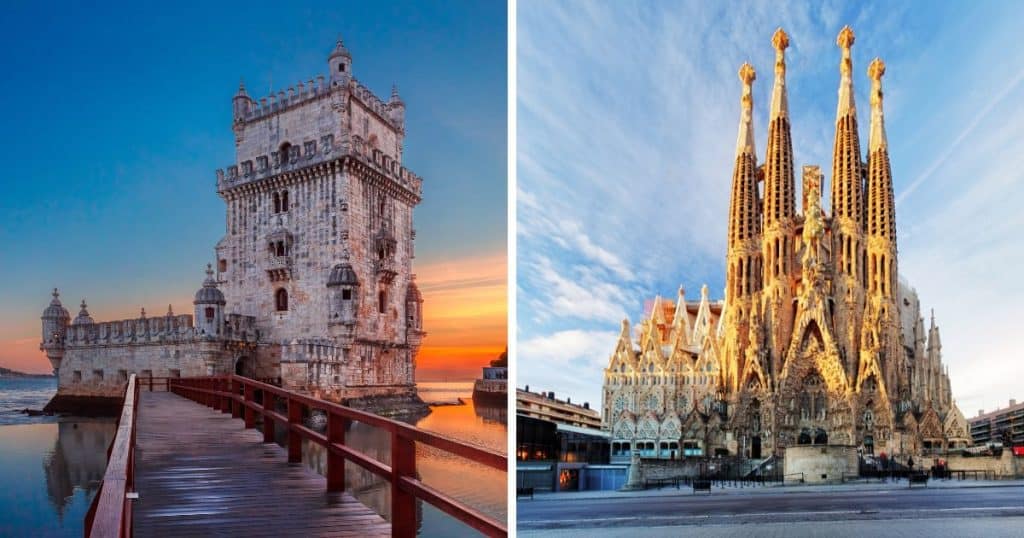
Are you planning a trip to Europe and can’t decide between Portugal and Spain? Both countries offer a rich cultural experience, delicious cuisine, and breathtaking landscapes. In this section, we’ll compare the tourism and attractions of Portugal and Spain to help you make an informed decision.
Tourism in Portugal
Portugal is a small country but has a lot to offer tourists. The country is known for its beautiful beaches, historic cities, and charming villages. Lisbon, the capital of Portugal, is a vibrant city with colorful buildings, lively neighborhoods, and delicious food. In Lisbon, you can visit the Belem Tower, Jeronimos Monastery, and the Castle of Sao Jorge.
Porto, located in the north of Portugal, is famous for its port wine and historic center, which is a UNESCO World Heritage Site. The Douro Valley, located near Porto, is a beautiful region with vineyards, olive groves, and charming villages. The Algarve, located in the south of Portugal, has stunning beaches, cliffs, and caves. The region is perfect for sunbathing, swimming, and water sports.
Tourism in Spain
Spain is a large country with diverse landscapes, vibrant cities, and rich history. Madrid, the capital of Spain, is a cosmopolitan city with world-class museums, art galleries, and restaurants. Barcelona, located in the northeast of Spain, is famous for its architecture, beaches, and nightlife. In Barcelona, you can visit the Sagrada Familia, Park Guell, and the Gothic Quarter.
Andalusia, located in the south of Spain, is a region with a rich history, stunning architecture, and delicious food. Seville, Granada, and Cordoba are the most popular cities in Andalusia. Seville is famous for its cathedral, Alcazar, and Plaza de Espana. Granada is famous for the Alhambra, a stunning palace and fortress complex. Cordoba is famous for the Mezquita, a mosque-cathedral with a unique blend of Islamic and Christian architecture.
In conclusion, both Portugal and Spain offer a unique and unforgettable experience for tourists. Whether you prefer beaches, historic cities, or charming villages, both countries have something to offer. It all depends on your personal preferences and travel style.
Are you ready to embark on a culinary adventure through the Iberian Peninsula? Portugal and Spain are two countries with rich and diverse cuisines that are sure to satisfy your taste buds. From hearty stews to fresh seafood, there’s something for everyone to enjoy. In this article, we’ll take a closer look at the cuisine highlights of these two countries. So, grab a glass of wine and get ready to indulge in the flavors of Portugal and Spain!
Cuisine Highlights
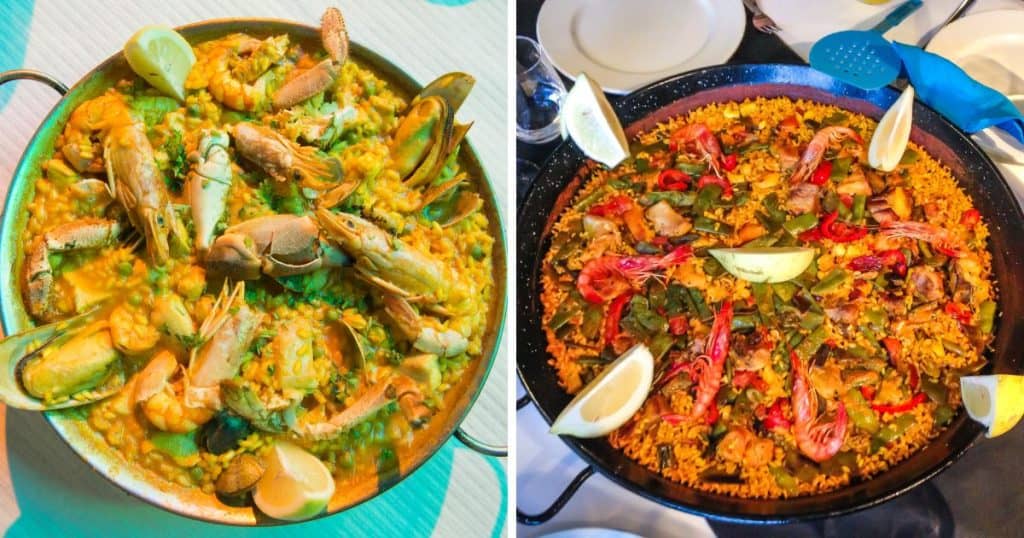
Portugal’s Cuisine
Portuguese cuisine is heavily influenced by its history of exploration and trade. The country’s location on the Atlantic coast means that seafood is a staple in many dishes. One of the most famous dishes is bacalhau, or salt cod. It’s said that there are 365 ways to cook bacalhau, one for every day of the year! Other popular seafood dishes include grilled sardines, octopus salad, and shrimp in garlic sauce.
In addition to seafood, Portugal is also known for its hearty stews. Cozido is a meat and vegetable stew that is traditionally cooked in a clay pot. Caldo verde is a soup made with potatoes, kale, and chorizo. And, of course, we can’t forget about the famous pastel de nata, a creamy custard tart that originated in Lisbon.
Spain’s Cuisine
Spain is a country with many regional cuisines, each with its own unique flavors and ingredients. One of the most famous dishes is paella, a rice dish that originated in Valencia. It’s typically made with saffron, chicken, rabbit, and seafood. Another popular dish is gazpacho, a cold soup made with tomatoes, cucumbers, peppers, and bread.
Spain is also known for its cured meats, such as jamón ibérico and chorizo. These meats are often served as tapas, small plates that are meant to be shared. Other popular tapas include patatas bravas, fried potatoes with a spicy tomato sauce, and tortilla española, a potato and onion omelet.
Whether you’re a seafood lover or a meat enthusiast, both Portugal and Spain have something to offer. From traditional stews to modern tapas, there’s no shortage of delicious food to try. So, the next time you’re planning a trip to the Iberian Peninsula, be sure to come hungry and ready to indulge in the flavors of Portugal and Spain!
Before You Go
After exploring the differences between Portugal and Spain, it’s clear that both countries have a lot to offer. Whether you’re looking for stunning beaches, rich history, or delicious cuisine, you’re sure to find it in either country.
While Portugal may be smaller in size, it certainly doesn’t lack in charm. Its beautiful cities, such as Lisbon and Porto, offer a unique blend of old-world charm and modern amenities. Plus, its coastline is dotted with picturesque fishing villages and stunning beaches.
On the other hand, Spain’s larger size means that it has a wider variety of cities to explore. From the bustling metropolis of Madrid to the artistic hub of Barcelona, there’s something for everyone. And let’s not forget about the delicious food and wine that Spain is famous for.
Ultimately, the choice between Portugal and Spain comes down to personal preference. Whether you’re looking for a quiet beach getaway or a bustling city break, both countries have something to offer. So why not plan a trip to both and see for yourself which one you prefer?
Are you ready to embark on a journey to two of Europe’s most beautiful countries? Spain and Portugal are both located on the Iberian Peninsula and share many similarities, yet each country has its own unique charm. Whether you’re planning a vacation, a honeymoon, or a move abroad, you may have some questions about which country is right for you. In this article, we’ll answer some frequently asked questions about Portugal vs Spain, so you can make an informed decision about your next adventure.
FAQs
What are the top tourist destinations in Spain and Portugal?
Spain has many popular destinations, including Barcelona, Madrid, Seville, and Valencia. Some of the top tourist attractions in Spain include the Sagrada Familia in Barcelona, the Alhambra in Granada, and Park Guell in Barcelona. Portugal also has many must-see destinations, such as Lisbon, Porto, the Algarve, and Madeira. Some of the top tourist attractions in Portugal include the Belem Tower in Lisbon, the Douro Valley wine region, and the beaches of the Algarve.
Which country is more affordable to live in, Spain or Portugal?
Both Spain and Portugal are generally more affordable than other Western European countries. However, Portugal tends to be slightly cheaper than Spain in terms of cost of living, especially when it comes to housing and groceries. That being said, the cost of living can vary depending on where you live in each country.
What are the best things to do in Spain and Portugal in December?
December is a great time to visit Spain and Portugal, as the weather is mild and there are many holiday festivities to enjoy. Some of the best things to do in Spain in December include visiting Christmas markets in Madrid and Barcelona, seeing the Three Kings Parade on January 5th, and skiing in the Sierra Nevada Mountains. In Portugal, you can enjoy Christmas lights in Lisbon, attend the Funchal Christmas and New Year’s Eve festivities, or visit the medieval town of Obidos.
Which country is better for a vacation, Spain or Portugal?
Both Spain and Portugal offer a wide variety of activities and attractions for tourists. Spain is known for its vibrant nightlife, stunning architecture, and beautiful beaches, while Portugal is known for its charming towns, delicious food, and scenic coastline. Ultimately, the best country for a vacation depends on your personal preferences and interests.
What makes Spain and Portugal great honeymoon destinations?
Spain and Portugal both offer romantic settings for couples on their honeymoon. Spain has many luxurious hotels and resorts, as well as beautiful beaches and historic cities. Portugal also has many romantic destinations, such as the Douro Valley wine region, the Algarve beaches, and the charming town of Sintra.
Why are Spain and Portugal separate countries despite sharing a language and culture?
Spain and Portugal were once part of the same kingdom, but they became separate countries in the 12th century. Over time, they developed different cultures and traditions, even though they still share many similarities. Today, both countries have their own unique identities and are proud of their individual histories and cultures.
Now that we’ve answered some of your burning questions about Portugal vs Spain, it’s time to start planning your trip. Whether you choose to explore the vibrant cities of Spain or the charming towns of Portugal, you’re sure to have an unforgettable experience.

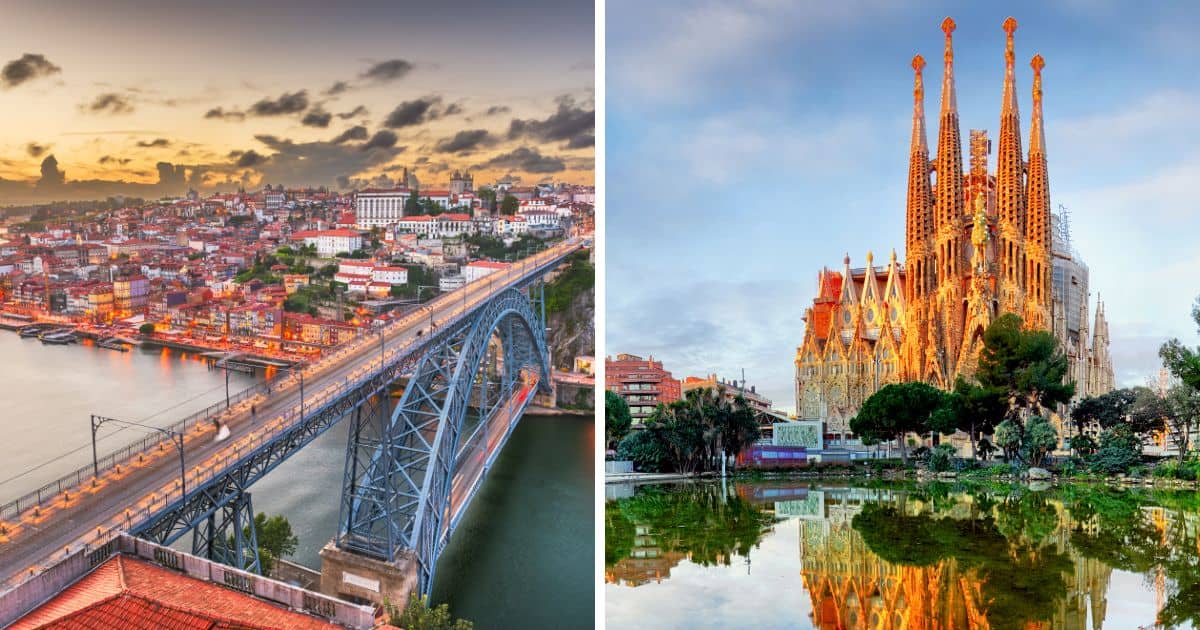




Leave a Reply